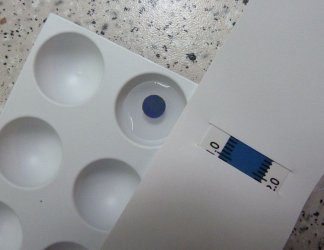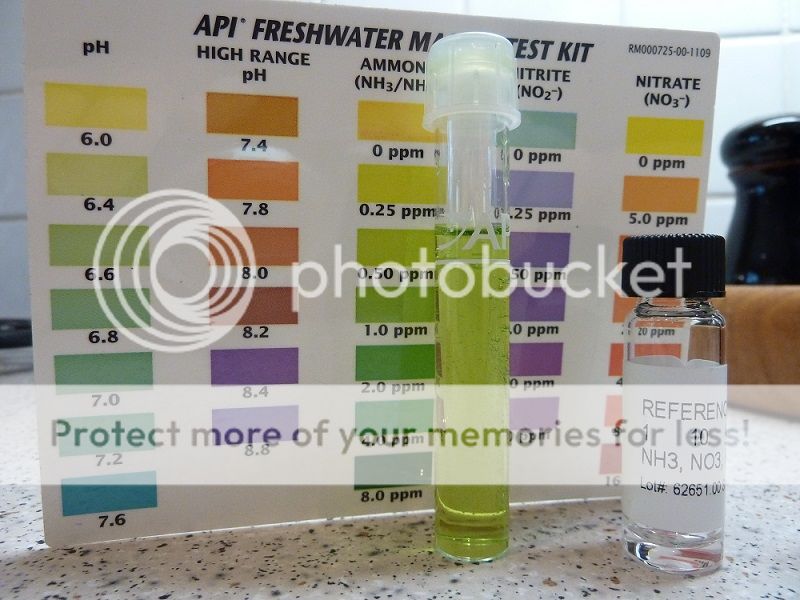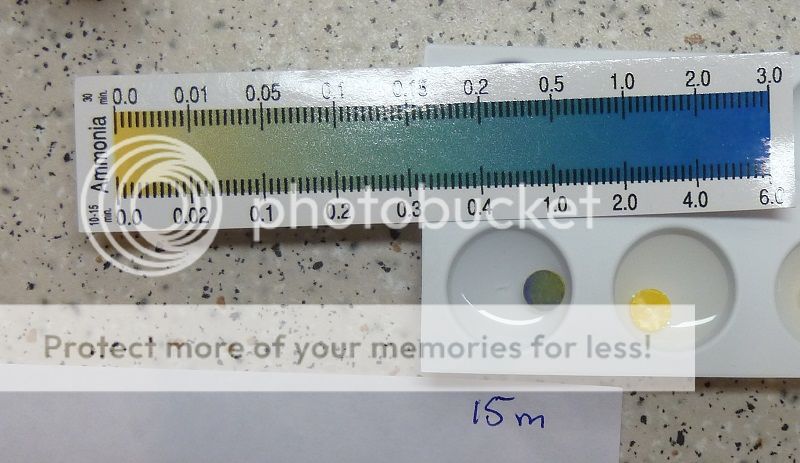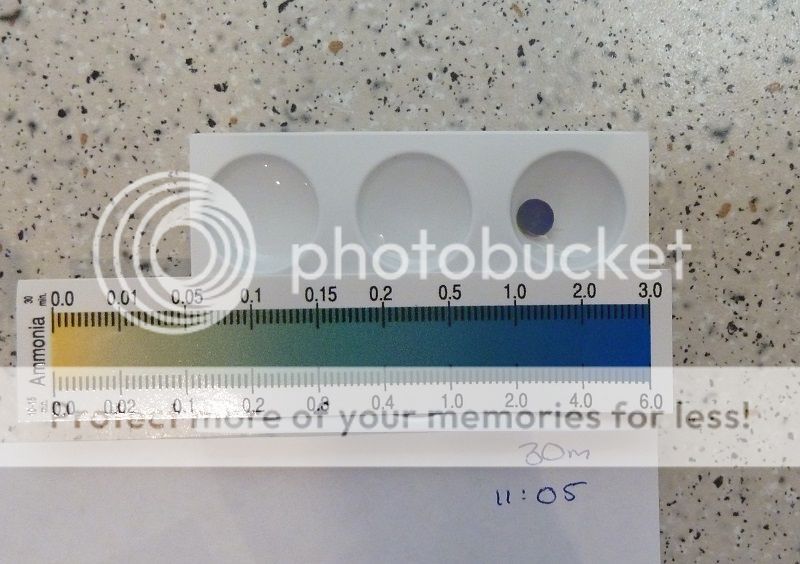Yeah, it looks now it's either the tests or the ammonium chloride recommended dosage isn't adding up the ammonia level it claims it it would. I wouldn't buy another ammonia test, unless you want one but I'd instead get an ammonium hydroxide bottle with a known concentration/percentage of ammonia, calculate how much you need to dose for a certain volume of water taking into consideration any substrate or decoration, etc.. then test with the two tests you have. You can't really know now unless you are sure how much ammonia you are actually adding.
You are using an out of date browser. It may not display this or other websites correctly.
You should upgrade or use an alternative browser.
You should upgrade or use an alternative browser.
Ammonia Testing- The Good, The Bad And The Ugly
- Thread starter TwoTankAmin
- Start date
April FOTM Photo Contest Starts Now!

🏆 Click to enter! 🏆
Yep I could just buy general household ammonia, TTA has sent me instructions for diluting it to specific concentrations. I'm not sure that I trust a bottle of Kleenoff to be true to its label though.
Also I have no further use for yet another source of ammonia but I could use another test kit! It feels wrong to have more bottles of ammonia in the house than test kits when the aim is to try to keep fish alive Practicality before science I'm afraid.
Practicality before science I'm afraid.
If these Salifert tests don't work then sensibly I should just send them back and ask for a refund. I can't make head nor tail out of them.
Also I have no further use for yet another source of ammonia but I could use another test kit! It feels wrong to have more bottles of ammonia in the house than test kits when the aim is to try to keep fish alive
 Practicality before science I'm afraid.
Practicality before science I'm afraid.If these Salifert tests don't work then sensibly I should just send them back and ask for a refund. I can't make head nor tail out of them.
I'm not sure that I trust a bottle of Kleenoff to be true to its label though.
Also I have no further use for yet another source of ammonia but I could use another test kit
Yeah, you would make use of an ammonia test better
I use the Kleenoff ammonia for fishless cycle and it's corresponding fine dosage/test related.
TwoTankAmin
Fish Connoisseur
daize- if you really want to do it scientifically, you can order 100g of powdered ammonium chloride for £2.99 plus shipping here http /mistralni.co.uk/products/ammonium-chloride?oo=41647924
/mistralni.co.uk/products/ammonium-chloride?oo=41647924
Next use it with the following recipe to make accurate test solutions:
 /www.caslab.com/EPA-Methods/PDF/EPA-Method-3501.pdf
/www.caslab.com/EPA-Methods/PDF/EPA-Method-3501.pdf
The reason they refer to it being dried is in order to insure there is no moisture content. Also, reagent water basically means ro/di water.
 /mistralni.co.uk/products/ammonium-chloride?oo=41647924
/mistralni.co.uk/products/ammonium-chloride?oo=41647924Next use it with the following recipe to make accurate test solutions:
From http7.11 Stock solution: Dissolve 3.819 g of anhydrous ammonium chloride, NH4Cl (CASRN 12125-02-9), dried at 105°C, in reagent water, and dilute to 1 L. 1.0 mL = 1.0 mg NH3-N.
7.12 Standard Solution A: Dilute 10.0 mL of stock solution (Section 7.11) to 1 L with reagent water. 1.0 mL = 0.01 mg NH3-N.
7.13 Standard Solution B: Dilute 10.0 mL of standard solution A (Section 7.12) to 100.0 mL with reagent water. 1.0 mL = 0.001 mg NH -N
 /www.caslab.com/EPA-Methods/PDF/EPA-Method-3501.pdf
/www.caslab.com/EPA-Methods/PDF/EPA-Method-3501.pdfThe reason they refer to it being dried is in order to insure there is no moisture content. Also, reagent water basically means ro/di water.
7.1 Reagent water - Ammonia free: Such water is best prepared by passage through an ion exchange column containing a strongly acidic cation exchange resin mixed with a strongly basic anion exchange resin. Regeneration of the column should be carried out according to the manufacturer's instructions. Note:All solutions must be made with ammonia-free water.
TwoTankAmin
Fish Connoisseur
Here is a link to an interactive NH3/NH4+ calculator. It works for fresh or salt. For fresh I use 0 for the reading under Salinity.
1. In the initial box for ammonia select NH (NH3 + NH4).
2. In the box for Total Ammonia Measurment put in the ppm reading from your API (or similar) test kit.
3. Enter you tank's pH and Temp. and then click on Calculate:
The number you want to know is the one for NH3 Concentration- that is the toxic form and is harming fish starting at .05 ppm according to the Merck Veterinary Manual.
http /www.hamzasreef.com/Contents/Calculators/FreeAmmonia.php
/www.hamzasreef.com/Contents/Calculators/FreeAmmonia.php
1. In the initial box for ammonia select NH (NH3 + NH4).
2. In the box for Total Ammonia Measurment put in the ppm reading from your API (or similar) test kit.
3. Enter you tank's pH and Temp. and then click on Calculate:
The number you want to know is the one for NH3 Concentration- that is the toxic form and is harming fish starting at .05 ppm according to the Merck Veterinary Manual.
http
 /www.hamzasreef.com/Contents/Calculators/FreeAmmonia.php
/www.hamzasreef.com/Contents/Calculators/FreeAmmonia.phpI finally got my hands on a Seachem Ammonia Multitest kit ready to start cycling my new 120L tank. 
I'm already impressed with it. It reads 2ppm for a dose of Dr Tim's ammonium chloride as I would expect, whereas the API kit only reads 1ppm. That immediately makes me think it's more likely to be accurate and adds weight to my suspicions that the API kit is highly inaccurate!
I was surprised to find that Seachem uses a solid reusable 'sensor' instead of liquid reagents, so it's definitely different to the other tests on the market.
Anyhow, looks promising so far. I'll have fun getting familiar with it and giving it a thorough testing over the course of my fishless cycle!
I'm already impressed with it. It reads 2ppm for a dose of Dr Tim's ammonium chloride as I would expect, whereas the API kit only reads 1ppm. That immediately makes me think it's more likely to be accurate and adds weight to my suspicions that the API kit is highly inaccurate!
I was surprised to find that Seachem uses a solid reusable 'sensor' instead of liquid reagents, so it's definitely different to the other tests on the market.
Anyhow, looks promising so far. I'll have fun getting familiar with it and giving it a thorough testing over the course of my fishless cycle!
TwoTankAmin
Fish Connoisseur
Sweet- but bear in mind that the SeaChem Alert does not reset rapidly. It takes some time. For example, if you did a 50% wc, I am not sure how fast it would read 1. It is more useful as an alert than an instant test.
But what really makes me happy to see you post this is that it adds credence to what I have been saying about how trustworthy hobby test kits are. And therein lies a big pitfall. Most of us tend to trust our test results even when they give a result that does not really make sense. You dosed the drops back when you used his bacteria, you noted the API result was not 2 ppm and most of us assumed that there was something wrong with the Ammonium Chloride and not the test.
This is why we should try to ask as many Qs as possible when trying to diagnose cycling related issues. When the test numbers don't make sense, look at them askance. It took me a lot of years and reading and testing to finally figure this out and I am barely scratching the surface.
But what really makes me happy to see you post this is that it adds credence to what I have been saying about how trustworthy hobby test kits are. And therein lies a big pitfall. Most of us tend to trust our test results even when they give a result that does not really make sense. You dosed the drops back when you used his bacteria, you noted the API result was not 2 ppm and most of us assumed that there was something wrong with the Ammonium Chloride and not the test.
This is why we should try to ask as many Qs as possible when trying to diagnose cycling related issues. When the test numbers don't make sense, look at them askance. It took me a lot of years and reading and testing to finally figure this out and I am barely scratching the surface.
I agree. This isn't the same as a Seachem Alert though. Here's the link to what I bought: Seachem MultiTest Ammonia
I only got one picture of the test I did today but this should give you a little idea of how it works:

The blue dot floating in the test sample is the 'sensor'. They initially look like little round yellow paper dots which you have to handle with a pair of supplied tweezers. They change colour and then return to a special container where they are supposed to 'regenerate' after the test.
I'll get some more pictures of the kit when I do the next test. One thing I noticed is this kit claims to be less susceptible to interference than other types of test kit. I think it's possible that something has been interfering with the other test kits I've tried and this one may be immune.
I only got one picture of the test I did today but this should give you a little idea of how it works:

The blue dot floating in the test sample is the 'sensor'. They initially look like little round yellow paper dots which you have to handle with a pair of supplied tweezers. They change colour and then return to a special container where they are supposed to 'regenerate' after the test.
I'll get some more pictures of the kit when I do the next test. One thing I noticed is this kit claims to be less susceptible to interference than other types of test kit. I think it's possible that something has been interfering with the other test kits I've tried and this one may be immune.
TwoTankAmin
Fish Connoisseur
daize your test and the ammonia alert use the same technology "This kit is based on the same gas exchange technology that is used in the Ammonia Alert™"
They are both slow to be "reusable", but they will tell you what the other kits don't how much NH3 is present.
But take what SeaChem says with a grain of salt. Look at what they state re Satbility and live nitrifying bacteria:
They are both slow to be "reusable", but they will tell you what the other kits don't how much NH3 is present.
But take what SeaChem says with a grain of salt. Look at what they state re Satbility and live nitrifying bacteria:
Nope no live nitrifyers in our product.
The bacteria used in competing products are inherently unstable. The conditions necessary for their growth and development fall into a very narrow range of temperatures, pH, organic loads, etc. When any of these parameters are not strictly within the proper range, the bacterial culture quickly crashes and dies. Stability® does not contain any of the aforementioned bacteria.
Seachem were kind enough to provide a 1mg/L ammonia reference solution so I thought I would put both test kits to the test.
This is what the API ammonia test looked like after the prescribed 5 mins. It clearly reads 0.5ppm instead of the expected 1.0ppm. I can't say if my test kit is faulty or typical of all API test kits but I think I can safely say this is the reason why my first attempt at fishless cycling failed so miserably!

Here is the Seachem Ammonia Multitest after 15 minutes. Ignore the yellow disc on the right, that's my tank test. The reference test is the blue-green disc on the left. I found this somewhat difficult to read since the colour is not uniform. However the instructions state that the true colour is the darker colour at the edge of the sensor disc, which is clearly showing blue, so I can see that the true reading is at least 1.0 ppm if not higher.

The Seachem test allows you to leave the sensor for 30 minutes if required to get a more accurate reading, so I checked again after 30 minutes. This time we compare against the colours at the top of the test card rather than the bottom. In the photo the sensor has unfortunately rendered a bit purple, but to my eyes it was an exact match for 1.0ppm which is the correct value.

In conclusion: the Seachem test appears to be far more accurate than API.
This is what the API ammonia test looked like after the prescribed 5 mins. It clearly reads 0.5ppm instead of the expected 1.0ppm. I can't say if my test kit is faulty or typical of all API test kits but I think I can safely say this is the reason why my first attempt at fishless cycling failed so miserably!

Here is the Seachem Ammonia Multitest after 15 minutes. Ignore the yellow disc on the right, that's my tank test. The reference test is the blue-green disc on the left. I found this somewhat difficult to read since the colour is not uniform. However the instructions state that the true colour is the darker colour at the edge of the sensor disc, which is clearly showing blue, so I can see that the true reading is at least 1.0 ppm if not higher.

The Seachem test allows you to leave the sensor for 30 minutes if required to get a more accurate reading, so I checked again after 30 minutes. This time we compare against the colours at the top of the test card rather than the bottom. In the photo the sensor has unfortunately rendered a bit purple, but to my eyes it was an exact match for 1.0ppm which is the correct value.

In conclusion: the Seachem test appears to be far more accurate than API.
Latest Discussions
- Replies
- 10
- Views
- 174
- Replies
- 12
- Views
- 163
trending
-
-
-
-
-
F-1 Angel... a bit nervous... it'll be my 1st F-1 fish...
- Started by Magnum Man
- Replies: 17
Staff online
-
FishmanicTFF Contest Czar

